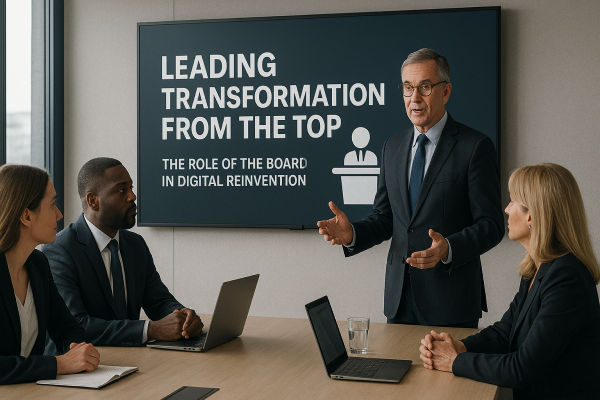Reclaiming Strategic Leadership in the Digital Era
Too often, digital transformation is misunderstood as an operational issue—a project owned by IT or delegated to operations. But in FMCG, distribution, mining, oil & gas, and heavy equipment sectors, where margins are thin and risk is structural, transformation must be a board- level concern. Strategic leadership in the digital era means more than approving budgets or technology pilots. It means directly shaping how the business will evolve, compete, and scale in a world where digital fluency is a prerequisite for survival.
Digital Failure Often Starts with Strategic Ambiguity
When transformation efforts stall, it’s rarely because the tools failed—it’s because leadership failed to own the direction. Boards and C-suites may advocate change in principle, but leave execution to middle management without aligning incentives, roles, or metrics. In multi-site, multi-entity enterprises, this results in fragmented digital initiatives, inconsistent platforms, and unclear success criteria. The outcome? No one feels fully accountable, and transformation becomes episodic rather than systemic.
From Vision to Action: Closing the Leadership Execution Gap
For transformation to succeed, executive alignment must go beyond shared vision—it must translate into shared ownership. In practice, this means defining clear roles across the C-suite: the CFO aligning digital investment with value drivers, the COO ensuring process readiness, and the CIO orchestrating scalable platforms. But more importantly, it requires the board to set the tone: reinforcing that digital reinvention is not a line of business initiative—it’s a new way of running the business.

Governing in Real Time: What Digital Boards Do Differently
Today’s boards must shift from passive oversight to active digital governance. This means integrating live operational and financial dashboards into board packs, tracking transformation KPIs in real time, and understanding how data architecture shapes business visibility. In high-risk industries, governing by lagging indicators is no longer acceptable. The modern board must ask: Are we using real-time insights to govern risk, reallocate capital, and accelerate outcomes?
Cross-Entity Alignment Starts at the Top
Multi-entity enterprises—common in mining and oil & gas—require centralized guidance and decentralized execution. If one site digitizes asset maintenance while another still runs spreadsheets, enterprise-level benefits collapse. Strategic alignment on platform standardization, data definitions, and reporting hierarchies must start at the top. Boards must ensure that transformation is coordinated, funded, and paced according to a group-level blueprint, not local experimentation. Embedding Accountability Into the Transformation Fabric The most successful digital reinventions are those where transformation is embedded into enterprise performance management. When digital milestones are linked to executive scorecards, site performance dashboards, and strategic planning cycles, they move from aspiration to non-negotiable. Boards must oversee not just progress— but persistence. This means asking: Is transformation episodic, or institutionalized? Is it someone’s project, or everyone’s business?
A Board-Level Mandate for Reinvention
Digital transformation is no longer optional, experimental, or technical. It is existential. And in capital-intensive, risk-heavy industries, it is also a strategic weapon. But it only becomes one if boards and executive teams lead from the front—owning the narrative, aligning the enterprise, and embedding accountability. In the next phase of industrial competition, the winners won’t be those with more data—but those with leadership sharp enough to turn that data into action, and action into advantage.
